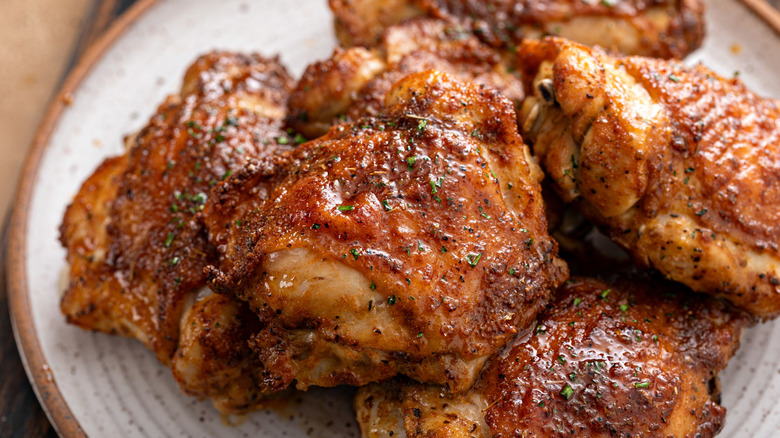The Best Way To Get Crispy Chicken Thighs Involves Getting Rid Of Water
We may receive a commission on purchases made from links.
Thighs are the way to go if you want the juiciest results with roasted chicken, but extra-crispy skin makes them impeccable. While chefs go about achieving this in various ways, Kaleena Bliss, the executive chef at the Chicago Athletic Association, which houses the rooftop dining experience at Cindy's, utilizes specific techniques to obtain a crunchy outer layer on her bird. Her philosophy:, "Crispy skin starts with dryness — moisture is the enemy of crisp."
Although it may seem counterintuitive given that ideology, starting with simple boiled water can help here (though, to be clear, Bliss didn't directly recommend this step when we spoke to her). Other sources suggest that pouring boiling water over the skin causes it to pucker and tighten around the meat while simultaneously rendering some of the fat beneath. Even if you skip this or instead brine your chicken, the key step to perfectly crispy roast chicken skin is to allow the moisture to dissipate. "If you've brined your chicken, try to remove it from the brine and let it air dry, uncovered, in the fridge for at least 12 to 24 hours," Bliss said. "I like to place the thighs skin-side up on a rack over a sheet pan during this time."
Once the thighs are thoroughly dried, reach for a heavy-bottomed pan like the Lodge 10.25-Inch Cast Iron Pre-Seasoned Skillet. Letting any remaining fat beneath the chicken skin render down is essential to getting it crispy. "Start the thighs skin-side down in a cold or moderately heated pan and let the fat slowly render out while the skin crisps," Bliss said. "Resist the urge to move them around—let that crust develop!"
Selecting the right chicken is also key
You'll only get the best results if you select the right meat in the first place. "A good chicken should feel fresh and wholesome, not beat up or artificially enhanced," Bliss said. "The meat should have a clean, natural color — no gray spots or bruising — and the skin should look intact, not torn or overly slimy."
The type of chicken you buy is also something to consider. Bliss noted, "For thighs and breasts, avoid pieces that look overly plumped or watery; those are often signs of added solutions or poor processing." However, some folks like to break down a whole chicken themselves to save a little dough. In that case, there are other things to bear in mind. "When buying whole chickens, give the bird a quick visual inspection," Bliss said. "The flesh should be firm and unblemished, and the packaging should be clean and tightly sealed."
As is typically the case with other proteins, taking the time to source chicken that is high quality will make cooking it to perfection easier. Water might be essential to achieving crispy skin, but if you buy poultry that looks like it is on its last legs at the grocery store, all the boiling water in the world won't improve it.

